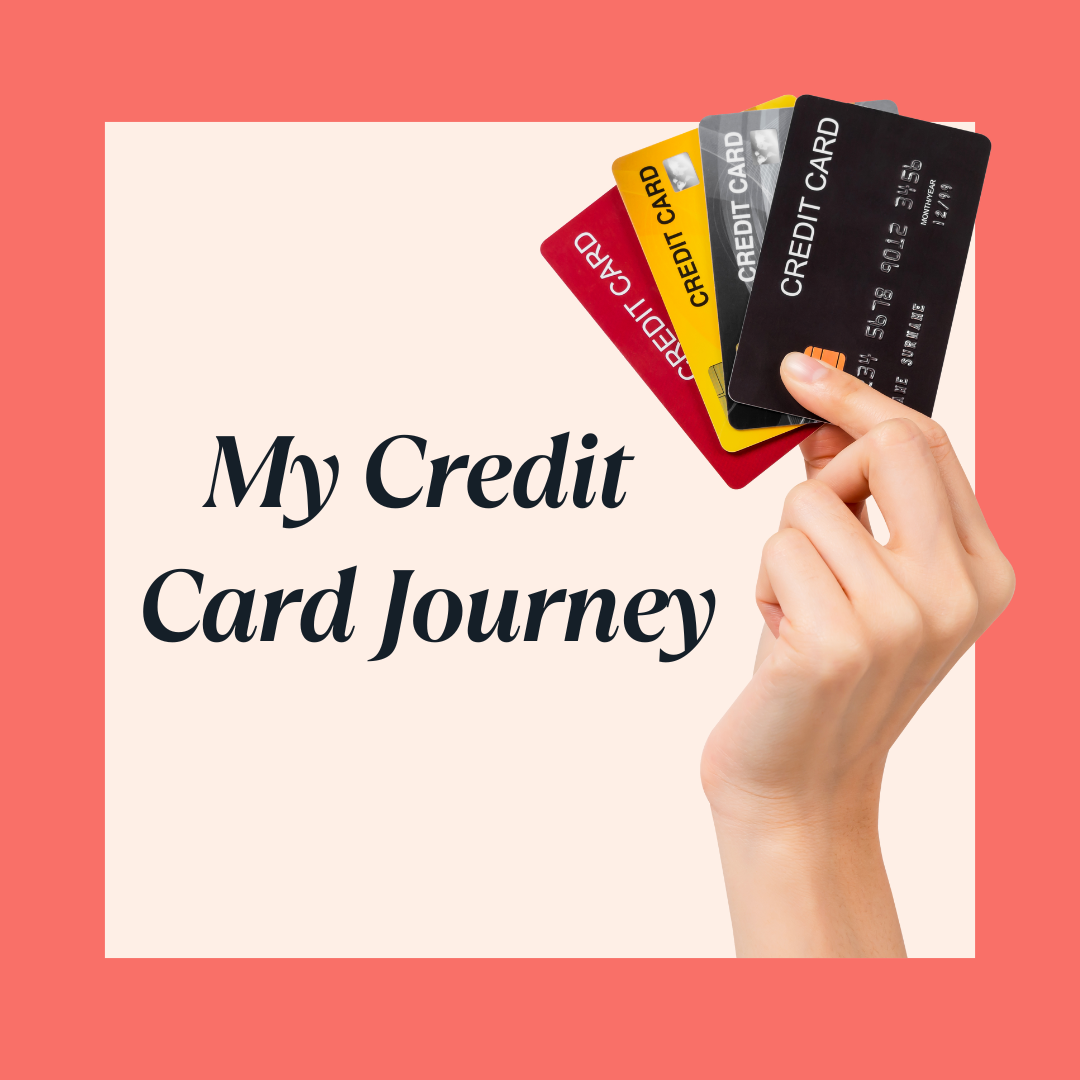In this blog post, I want to share my credit card journey to be transparent about how I got to where I am financially.
Disclaimer: This is not financial advice—I’m not a financial professional. I’m simply sharing what has worked for me in hopes it helps someone else.
This post may contain referral or affiliate links. If you apply through my link, I may earn a bonus—at no extra cost to you. I only recommend what I personally use and believe in.
When I started my credit card journey, I was completely clueless — I had never been taught about credit or how credit cards actually work. In fact, when I asked my parents about getting one at 19, they told me not to. Thankfully, I ended up attending a workshop at my community college about credit cards—and that one session sparked my interest in personal finance.
Now, at 25 years old, I’m proud of the financial growth I’ve made within my credit card journey—especially because I had to seek out that knowledge on my own. That’s why I’m passionate about being open about money and credit, especially for other first-gen students who might not know where to start.
If you haven’t already, I highly recommend checking out my intro blog post on credit cards. In that post, I cover the basics—why credit cards matter, how to avoid common mistakes, and what to look out for when choosing your first one.
Even if you already have a credit card, it’s packed with info I wish more people knew. You might be surprised by what you didn’t know—especially if no one ever really explained how credit works.
→ Credit Cards for College Students | How to Use Them Responsibly
My Credit Card Journey: Credit Card #1
Let’s rewind to when I was 19 and navigating my credit card journey with zero guidance. Like many first-gen students, I wasn’t taught about credit growing up. In fact, when I asked my parents if I should get a credit card, they told me not to. They weren’t being shady—they just didn’t know either.
Thankfully, I attended a credit card workshop at my community college, and that changed everything. That one hour unlocked a new curiosity in me about personal finance, and it led to my first real step into credit: the Discover It® Student Chrome card.
Now that I’m no longer in school, Discover transitioned me to the regular Discover It card. It’s basically the same thing, except I no longer qualify for their Good Grades Reward—which gives you a little cash back for maintaining a 3.0 GPA. I didn’t have to reapply or anything; they just converted it as I aged out.
Why I Picked this Card
To be completely honest, I applied because someone referred me. That’s it. No deep-dive research, no spreadsheet of pros and cons—just vibes.
Luckily, it worked out. As a first card, it did what it needed to do:
- Gave me access to credit
- Helped me build a payment history
- Didn’t charge me an annual fee
- And offered a simple cashback system
That’s really all you need at first. Your first credit card doesn’t need to have airport lounge access or 5% back on bougie categories. In fact, those cards probably wouldn’t approve you anyway if you have no credit history—and the perks are usually balanced out by hefty annual fees.
Looking back, I do wish I had compared options. But to this day, the Discover It Student card still makes it onto NerdWallet’s best student credit cards list every year, so I don’t feel like I fumbled too hard. If you’re considering your first card for your credit card journey, definitely check out their lists:
👉 NerdWallet’s Best Student Credit Cards
👉 Best Starter Credit Cards for No Credit of July 2025
Side Note
If you’re brand new to credit cards, here’s something I didn’t know when I started:
You have to apply for a credit card. And applying for too many all at once? Is NOT a good look.
Every application results in a hard inquiry on your credit report, which can lower your score temporarily. If lenders see you applying for a bunch of cards at once, it can make you look like a risky borrower—even if you’re just curious.
So, apply with intention. Pick a card that you genuinely see yourself keeping for a while.
How I Used My Card
When I got my Discover card, I was given an $800 credit limit—which felt like a lot at the time. I used it for small, everyday purchases (groceries, gas, etc.), but I made sure to:
- Keep my balance under 10% of my credit limit
- Pay off the full balance on time every single month
That’s what credit bureaus love to see: low utilization and perfect payment history. And slowly, my score started growing.
I also took advantage of the Good Grades Reward Program, which gave me $20 cashback every school year I kept a 3.0 GPA. It wasn’t life-changing, but it was a nice little bonus.
What I Learned From This Card
This was my only credit card for three years, and while it helped build my credit history, I wish I had been more proactive. Specifically, I wish I had called Discover every few months to ask for a credit limit increase.
Why? Because a higher limit means:
- You can spend a bit more while keeping your utilization low
- Your score may rise faster
- You might earn more cashback on everyday purchases
Even though this card isn’t heavy on perks, it could’ve still worked harder for me if I’d known how to make those small moves. But that’s the point of this blog—to share what I learned so you can skip the trial-and-error part.
Why I Still Use My Discover It Card Today
Even though I now have three credit cards, I still use my Discover It card regularly. Why? Because when it comes to credit, it’s important to keep your accounts open and active—especially older ones that help your average age of credit.
Out of all the cards I have, my Discover It has actually become my go-to card for gas. It still gives me cashback when I fill up (and I usually pump a tank or two per month), so it’s simple, automatic, and still useful even years later.
Final Thoughts
If you’re just starting out and looking for your first credit card, I really do recommend the Discover It card. From my experience, Discover tends to be more credit starter friendly.
No, it’s not the flashiest card. But when you’re just starting your credit journey, that shouldn’t be your priority. You want to focus on:
- Building good habits
- Keeping your utilization low
- Paying your balances in full
- And avoiding cards with perks that tempt you into overspending
The rewards and bonuses will come later—when you know how to manage them without hurting your finances.
If you’re thinking about applying, here’s my referral link so we both get a little bonus from Discover if you’re approved:

My Credit Card Journey: Credit Card #2
Moving with my credit card journey, the second card I got was the Chase Freedom Unlimited, which I applied for at 22, after graduating college. And just like with my first card, I didn’t do any deep research—I applied because someone referred me. Thankfully, it worked out in my favor. This card has no annual fee, and it quickly became a big step up from my starter card.
Applying For This Card
This blog is all about transparency, so let me be honest:
I didn’t get approved for the Freedom Unlimited on the first try.
Here’s how it went down:
- First try: Denied during senior year of college—likely due to low income from only working summer jobs.
- Second try: Applied again post-grad with a part-time job—denied again.
- Third time’s the charm: Got a full-time job, applied again in late 2022, and was finally approved.
Tip #1: Space out your credit applications. Every application results in a hard inquiry on your credit report, and too many at once can drop your score or make you look risky to lenders.
Tip #2: You can also ask credit card companies why you got denied!
What I Liked About It
This card felt like a glow-up:
- Bigger credit limit
- Simple flat-rate rewards: 1.5% back on everything
- Bonus categories: 3% on dining and drugstores, 5% on travel booked through Chase
- No rotating categories to track
I liked that it rewarded me for spending in areas I was already spending—especially dining out.
It became my main credit card for a while because it offered more rewards and felt more “grown.” But I still kept my Discover It Card active, using it for gas and smaller purchases to keep that line of credit open.
Tip: If you don’t use a credit card at all during a statement period, your score can actually drop. To avoid that, I suggest putting a small recurring charge (like Netflix, Spotify, or your phone bill) on your backup card just to keep it active and reporting.
Final Thoughts
Even though the Freedom Unlimited isn’t my primary card anymore, I still think it’s a great no-annual-fee option, especially if you want easy rewards without juggling bonus categories.
→ Here’s my referral link if you’re thinking of getting one!

My Credit Card Journey: Credit Card #3
So now at the latest card within my credit card journey: the American Express Gold Card. And you’d think by this point, I’d be doing deep research, comparing perks, and reading fine print…
Nope.
Once again, I got referred by a friend, liked the aesthetic and prestige vibes, saw that it offered high points for dining out (which is one of my biggest expenses), and just applied.
I won’t lie—it has a $325 annual fee. But I’ve made it work and it’s honestly become one of my favorite cards. The points are great, especially if you’re someone who eats out often or orders delivery like I do.
Would I have picked it again if I had done more research? Maybe.
Do I regret it? Not really, but I got lucky. This card could’ve easily backfired if I wasn’t already in a place where I could manage it well.
Yes—$325 is a lot for an annual fee, especially when there are great cards out there with fees half that amount. But once I really understood the perks that come with the American Express Gold Card, it made a lot more sense. Here’s how I personally justify it:
- $10/month in dining credit
This applies to Grubhub, Cheesecake Factory, Five Guys, and Goldbelly. I usually just order Grubhub for pickup to avoid fees and get a mini discount.
→ That’s $120/year in value. - $10/month in Uber credit
I use this either for Uber rides (when I’m going out or out of town) or for Uber Eats. Some months I don’t use it, but overall, I make it work.
→ Another $120/year in value. - $7/month Dunkin’ Donuts credit
Now, I don’t live anywhere near a Dunkin’ (the closest one is an hour away from me…), but here’s my hack:
I downloaded the Dunkin’ app and load exactly $7 onto it using my Amex Gold card each month. So far (as of June 2025), it’s been working and crediting my statement.
→ That’s $84/year. - $100/year Resy dining credit
This is split into two $50 credits—one from January to June and one from July to December. You just need to dine at a qualifying Resy restaurant and pay with your Amex. Most are nice spots in big cities, which honestly fits my vibe.
→ Adds up to $100/year.
These perks total about $424/year in value—and that’s not even including points or other features. Since I only pay $325/year, it more than covers the annual fee as long as I actually use the benefits.
Tip: You have to enroll in these perks through your Amex account to activate them!
Sign-Up Bonus That Helped Me
When I got the card, there was a 60,000-point intro offer after spending $6,000 in the first 6 months—which I was able to meet because this became my primary card for dining, groceries, and everyday expenses.
Credit Limit Note
Amex Gold doesn’t have a preset spending limit (because it’s technically a charge card, not a traditional credit card). But that doesn’t mean unlimited spending—it just means the limit adapts to your behavior, income, and payment history. I still treat it like a credit card: spend responsibly, pay it off every month, and never carry a balance.
Final Thoughts
I’ll be honest—I probably didn’t need the Amex Gold Card. But it’s too late now, and thankfully, I made it work. Still, if I could go back, I would’ve taken the time to research more carefully and chosen a card that truly fit my spending habits from the start.
That said… I still love my Amex Gold. The perks are great, and yes—it definitely has some flex! I just want to be real about the fact that I jumped in without much research, and that’s not something I recommend you do.
If you’re shopping around for a credit card, I suggest using NerdWallet to compare features, fees, and rewards to find a card that fits you.
→ If you’re already interested in the Amex Gold, here’s my referral link so we both get a little bonus if you’re approved:

Future Plans
I’m not planning to open another credit card anytime soon. For now, my focus is on redeeming my points for travel—which, according to the points community, is one of the best ways to get maximum value.
I haven’t used it personally yet, but I’ve been told that PointHound.com is a good tool to compare redemptions and get more out of your travel points. Just putting it on your radar in case you’re curious too!
I also occasionally scroll through the 10xTravel Facebook Group, where people share how they use points for flights, hotels, and more. It’s a casual community (not all pros), but you can find some cool tips and hacks there:
👉 10xTravel Facebook Group
Why I Shared This
I hope my credit card journey helped you learn a little something—whether it’s a new hack or just what not to do. I wanted to be transparent because so many of us, especially in first-gen communities, are told that talking about money is rude.
But staying silent about money doesn’t help anyone—especially not people like us, who are trying to figure it all out from scratch.
I’m not a financial professional. I’m not telling you what to do. I’m just a first-gen Latina sharing my credit card story, so you can learn from my mistakes, my wins, and maybe skip some of the bumps along the way.


